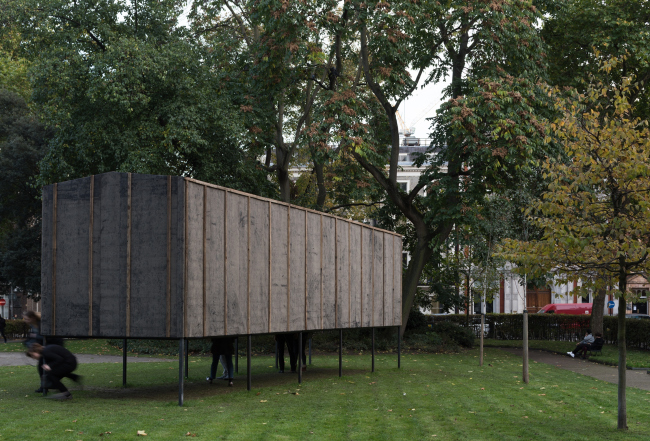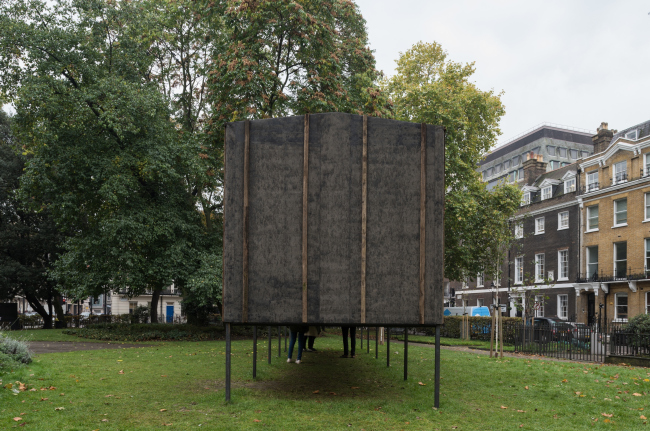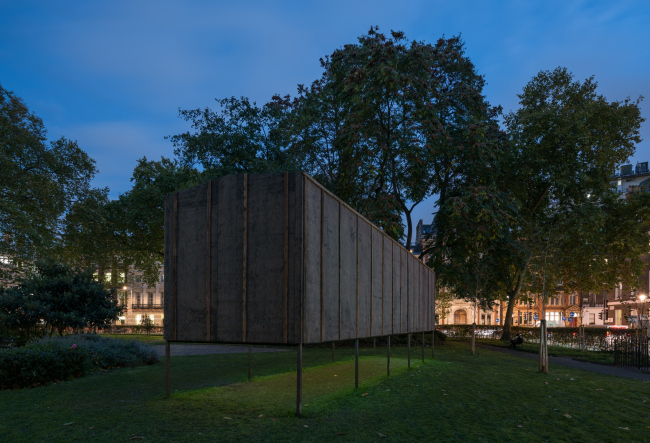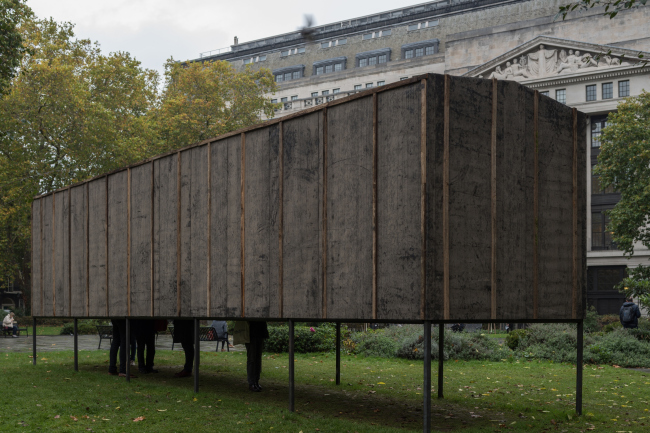|
Published on Archi.ru (https://archi.ru) |
|
| 23.10.2017 | |
|
A House That Hovers |
|
|
Julia Tarabarina |
|
|
As part of the project named “101st km Further Elsewhere”, Pushkin House opened in London a pavilion by Alexander Brodsky. This is Alexander Brodsky’s first work in London. Pavilion of the project “101st km Further Elsewhere”. Alexander Brodsky, Bloomsbury Square, London, 2017. Photograph © Yuri PalminFor a pavilion dedicated to Russian poetry in exile, Pushkin House could not have chosen an author more appropriate than Alexander Brodsky. All of his installations are so remote from construction industry and so close to poetry – subtle, nostalgic, quiet, and without fanfare – that one feels like placing them somewhere at the pole of the ultra-spectrum, one pole representing a thriving and successful round-bellied residential complex, and the other pole representing the silent poetry of a forced labor camp, poetry of falling into decay. This is the architecture of searching for subject and meaning, this meaning being of a peculiar kind when, instead of showing around what you have found, you hide it back under the covers of low-key imagery. It seems that Brodsky’s installations consciously reject everything pertaining to construction, throw it away as an old doorstep rug, relegating it to the austerity of a barrack: minimum of materials and minimum of color. As for the form, it is also present in them at a “minimum living wage level”. In a word, this is poetry of inner emigration, the way it was then, and the way it is now, so, Brodsky is the perfect figure for it in all senses. The project by Pushkin House “101st km Further Elsewhere” is dedicated to Russian poetry in exile and the centenary of the Russian revolution (I wonder if they have not prohibited calling it “coup d’etat” yet?) And it is sort of ironic, really, that Moscow no longer celebrates this day, maybe, being a little embarrassed by it) but London, in a sense, already has celebrated it. The project essentially consists of an exhibition of photographs of today’s Russian emigrant painters, public lectures, show-reels, and concerts that will take place in Pushkin House on Bloomsbury Square and in the pavilion in the nearby park. Pavilion of the project “101st km Further Elsewhere”. Alexander Brodsky, Bloomsbury Square, London, 2017. Photograph © Yuri PalminIn the pavilion, they show poetry – which is not something that is typical for an exhibition. But then again, the curators stress, the pavilion is not an exhibition but an independent installation. On the plywood partitions, fastened with clothespins, there are paper sheets with poetry by Mandelstam, Tsvetaeva, Khodasevich, Pasternak, and Joseph Brodsky – it’s a narrative about exiled poets as much as about killed ones; the sheets are lit by small spotlights. Upon the side wall, a video of railroad tracks is projected. According to the narrative, the pavilion is a metaphor of a train car that rides beyond the 101st kilometer, a concept well known in Russia, which refers to the distance that poets and other politically unreliable citizens were forced to maintain from major cities, often after returning from the labor camps. The second part of the title “further everywhere” refers to the poetic and mysterious announcement heard on local trains leaving from Moscow, a general denominator for calling points after the center of the city, that conjures up the vast expanses of Russia, and the rest of the world beyond its borders – wherever the exiled is forced to go. Some god-forsaken car, very much like one that transported the prisoners, rides beyond the 101st kilometer and – further elsewhere – lands in London. On the outside, however, the impression of a train car is completely gone – the architects don’t even make an attempt to achieve any likeness to one – rather, it looks like a shed or a barrack elevated about a meter on thin legs of metallic framework, and finished with vertical poles that look as if they were meant to hold roofing felt in place, but, again, there is no roofing felt here, instead of it, there is only plywood, painted transparent black. Pavilion of the project “101st km Further Elsewhere”. Alexander Brodsky, Bloomsbury Square, London, 2017. Photograph © Yuri PalminPavilion of the project “101st km Further Elsewhere”. Alexander Brodsky, Bloomsbury Square, London, 2017. Photograph © Yuri PalminAnother interesting detail: the pavilion has neither entrance nor exit. Meaning – there are no doors, and one can only enter by bending down uncomfortably. This is a common exposition technique of today – it helps to further isolate the spectator from reality and concentrate all of his feelings on what is going on inside (at the same time providing a small amount of physical exercise). Everyone here is already accustomed to that, and no one is surprised that you have to nearly crawl into the pavilion. Here it’s a bit different, though: sometimes, this technique is used arbitrarily but in this particular instance it takes on a powerful metaphorical meaning of “no way out” (as they used to write in the Moscow metro before these signs were at long last replaced with “no exit” signs). It also symbolizes the depth of the emigration, not so much physical as spiritual, fate of the repressed poets drawing inward, like there is really “no way out”. Few things were as easy as getting sucked in by the repression machine – the unlucky individual didn’t even always know where exactly he came in and what he did wrong but from this point on, he belonged to “the other pack”, neither here nor there. And this is what gives us this image of a house that hovers over the ground, a house doesn’t even look like one. A house with no roots, with no proverbial “land plot” – it just landed here ready to take off again carrying out its ethereal verbal content. At night, when the inside lights illuminate a rectangle above the pavilion, the “hovering” effect is enhanced even more. Pavilion of the project “101st km Further Elsewhere”. Alexander Brodsky, Bloomsbury Square, London, 2017. Photograph © Yuri PalminOne more thing: if we are to watch this building from a distance, we get a feeling that all these ghost people reading poetry inside of it literally carry this house on their shoulders, like a snail carries its shell around. This is a burden of poetry and emigration that the poets have always carried and are carrying on their shoulders. Pavilion of the project “101st km Further Elsewhere”. Alexander Brodsky, Bloomsbury Square, London, 2017. Photograph © Yuri PalminPavilion of the project “101st km Further Elsewhere”. Alexander Brodsky, Bloomsbury Square, London, 2017. Photograph © Yuri Palmin |
|






